South Carolina 1860 $5
The Bank of Hamburg, South Carolina
The City of Hamburg, South Carolina no longer exists today, save a few old buildings which do little to evoke the history of it’s sad past. The town was founded in 1821 by Henry Shultz, who immigrated from Hamburg, Germany. Situated on the border with Georgia, Hamburg, South Carolina sat along the Savannah River, with Augusta, Georgia on the other side. Hamburg was also located at a terminus of the South Carolina Railroad line. At 136 miles from Charleston, S.C. to Hamburg, S.C., it was at that time the longest line in the entire world. It’s said that Shultz has a long dream of having a town along the north side of the river – and it’s also said that he started the town due to a disagreement with the officials on the South Carolina side. Whether either one – or both – are true, Hamburg was founded and soon began to prosper.
Hamburg competed with Augusta in the transportation of cotton bales both by wagon-load and by boat. This competition effectively ended when, in 1847, Augusta finished a canal that provided a quicker, easier mode of transportation, and provided power and created industry along the canal banks. The canal turned Hamburg into a veritable ghost town that even the longest rail line couldn’t help. Throughout the Civil War years Hamburg continued to decline as men went off to war and merchants relocated across the river to Augusta, Georgia.
After the Civil War ended, Hamburg experienced a short lived resurgence when it was occupied and populated by emancipated slaves. This unfortunately did not last long, as on July 08, 1876, what became known as the Hamburg Massacre took place, in which six blacks and 1 white were killed.
The incident was ignited by a court case in which free passage on a public road was disputed. An armed force of more than 100 whites had assembled in the area in order to try to influence the outcome of a gubernatorial race, and that same force restricted the passage along the road. During the subsequent court case for that offence, the same armed force attacked a National Guard Armory manned by a black regiment, numbering about 30. Two of the National Guardsmen were killed when they were leaving, and another four were captured.
Later in the night there was some discussion amongst the group of whites as to what to do with the four captives.
They decided to kill them.
A local white man was also reported killed by the mob, though it is uncertain as to exactly when this occurred.
The incident was actually not about the free passage on a road, but rather an organized attempt by the Democrats in the state trying to suppress the blacks from voting for the Republican Party in an upcoming election. The fallout from the massacre was a lot of hot rhetoric, and little effect. An investigation indicted 94 men with murder, but no-one was zero even prosecuted, much less convicted.
Despite the uproar around Hamburg Massacre, the suppression of black votes continued, and two more such massacres occurred in South Carolina. In Ellenton, over 100 blacks were killed in September 1876, and in October 1876, a black man and several whites were killed in the town of Cainhoy. The terrorism worked, and the democrats narrowly won the governor’s race, and an era of legal segregation was imposed.
Henry Shultz was a very ambitious man whose schemes didn’t always pay off. When an attempt to finance a bridge across the river failed in 1819, he was so distraught that he had attempted to commit suicide with a pistol in his mouth. In a strange and -for Henry Shultz, fortunate incident, the pistol went off, but he survived. It is impossible to imagine how, but the shot exited between his eyes, leaving a horrific disfigurement of the face due to the scarring from the ball and the powder burns. His eyesight was reportedly unaffected by this wound, and he eventually recovered his full faculties.
Shultz himself was also convicted of murder. As the mayor of Hamburg, he pronounced a suspected thief to be whipped in order to gain a confession from the man. When the man died as a result of the wounds, Henry Shultz was arrested and being convicted of manslaughter, was placed in prison for several months.
Shultz eventually went bankrupt in 1828 and never found his was back to success. He died October 13, 1851 in apparent poverty.
Today, the city of Hamburg is no more. But in its place is North Augusta, South Carolina. North Augusta was incorporated in 1906, and today its main industries are retail, construction and manufacturing. Hamburg was located within North Augusta between the 5th Street Bridge and 13th Street Bridge.
There is scant information available about the Bank of Hamburg, and most of it seems to be only partially correct. It’s apparent that Henry Shultz chartered the Bank of Hamburg, but the management was undertaken by others. The signers of the note were somewhat difficult to trace, as there are many incorrect reports. These inconsistencies perplexed me somewhat as they did not match the note below, nor many others I referenced.
The answer came within the November 1869 Report of the Comptroller General to the General Assembly of the State of South Carolina, Reports and Resolutions, that the signature below matched to the others reported. The signature of the President of the bank is signed by J. W. Stokes.
Antebellum Southern Bankers asserts that Augustus DeCottes served as a teller from 1850-1865 and also as the cashier from 1858-1865. The note is assuredly signed by the bank’s cahier, A. C. (Augustus Cornelius) DeCottes.
The History of the Banking Institutions Organized in South Carolina Prior to 1860 – by Washington Augustus Clark (published in 1922) even further confirmed these were correct signatures. In addition, it went on to state that “you should beware of notes signed by J.M. or W. Tillman, Cash., and of Henry Shultz, Pres.”

